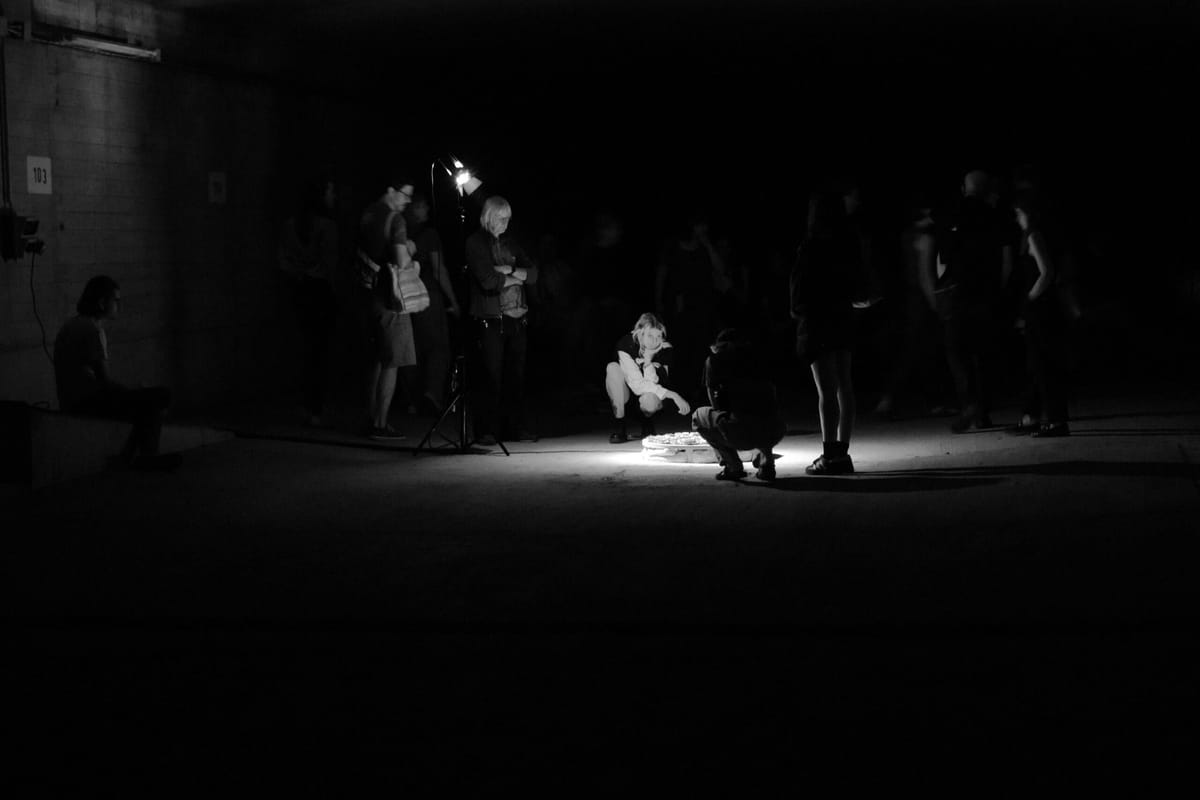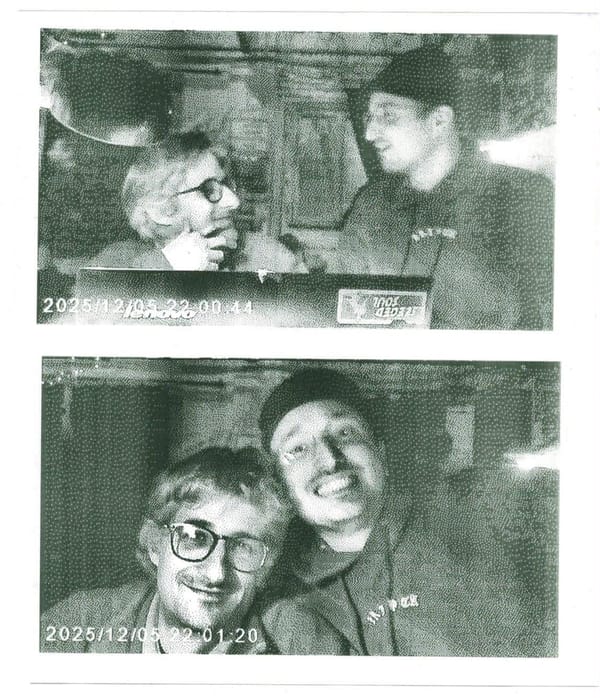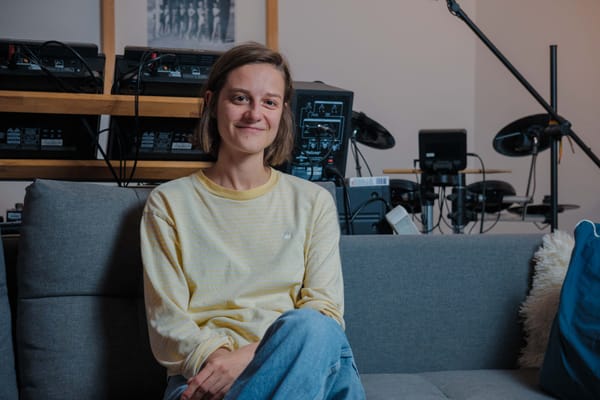Register for free to receive our newsletter, and upgrade if you want to support our work.
It’s the evening of a warm, sunny August day as I’m cycling towards one of the eight bridges of Cologne to meet the artist Vica Pacheco for an interview – only that she has seen little of the blue sky that day. It is two days before the opening of this year’s Brückenmusik, and after spending the whole day inside of the Deutzer Brücke, Pacheco and her helpers from the Brückenmusic team compare who walked the most steps (Volker Zander, one of the seven organizers, did 18 000 steps the other day).
During a couple of days every year since 1995, there is a sound art intervention in the bridge that connects Cologne’s city center with the Schälsick* district Köln-Deutz. Initiator Peter Behrendsen, who was a radio producer and composer, was made aware by American artist Bill Fontana that there must be a hollow accessible space inside of the bridge. Fontana inaugurated the inside of the bridge with a sound piece in 1985. 10 years later, Behrendsen started Brückenmusik. Since then, he and the curators that followed him have invited a variety of sound artists and musicians to turn the Deutzer Brücke into one of the most remarkable listening sites.
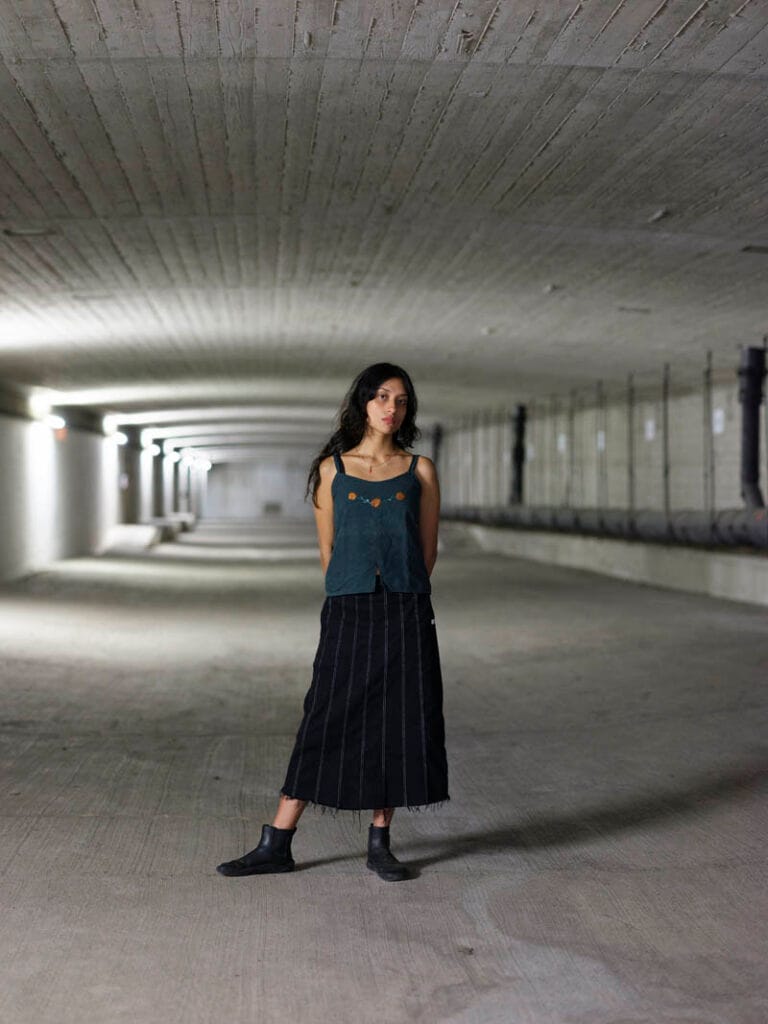
This year, the Brückenmusik artist is Vica Pacheco. It is not uncomplicated to determine where Pacheco is based. She was born in Mexico in 1993, studied in France and now travels the world for residencies and shows. Her plants, her friends and her tower computer however are in Brussels. Just as difficult to answer is the question of what is the core of Pacheco’s practice. She learnt to play the guitar at an early age and studied fine arts in Mexico, but found many pieces coming together when she moved to France to continue her studies. She truly is transdisciplinary: she creates music autonomously and for others, she builds her own instruments for which she develops installations and performances, and her work contains a multitude of skills from handcrafts to mechanical and digital processes.
Verena Hahn
When you got the invitation to Brückenmusik, what was your starting point?
Vica Pacheco I wanted to work with ceramics because that’s what I do most of the time. I’m creating instruments that are half ceramics and half electronics, and with them I wanted to create a soundscape, pretending to be something that is not there, and evoke organic landscapes that inspire me a lot.
VH
What kinds of landscapes are those?
VP I’m coming from a subtropical place, and I’ve always been inspired by it. Insects, birds, wind, this kind of natural environment. I’m trying to create natural synthetic landscapes, let’s call it like that.
VH
Are all of the pieces that you’re showing created for Brückenmusik or are there also pieces from your archive?
VP What came back are the hydraulic flutes. The hydraulic flutes are instruments that I’ve been doing already for a few years. It’s an ancient Mesoamerican technology that works with movement and the water inside of the flute. When it’s moved, the water pushes the air through the only possible escape which creates a little whistle. This time I am using two of these flutes with some electronics for a kind of bird conversation.
VH
How would you describe these flutes? What do they look like and what is their personality?
VP Oh well, they have names! I give names to all of my flutes. One is called Conejo. This means “rabbit” in Español. It has the shape of a rabbit shadow. Conejo looks like two vases that communicate and one brings water to the other one. They also look a little bit like lovers kissing. And the other one I call Rama. Rama means “branch”. It’s a little bit snaky. It’s really thin and has a tubular shape. And both are green with a glaze of copper.
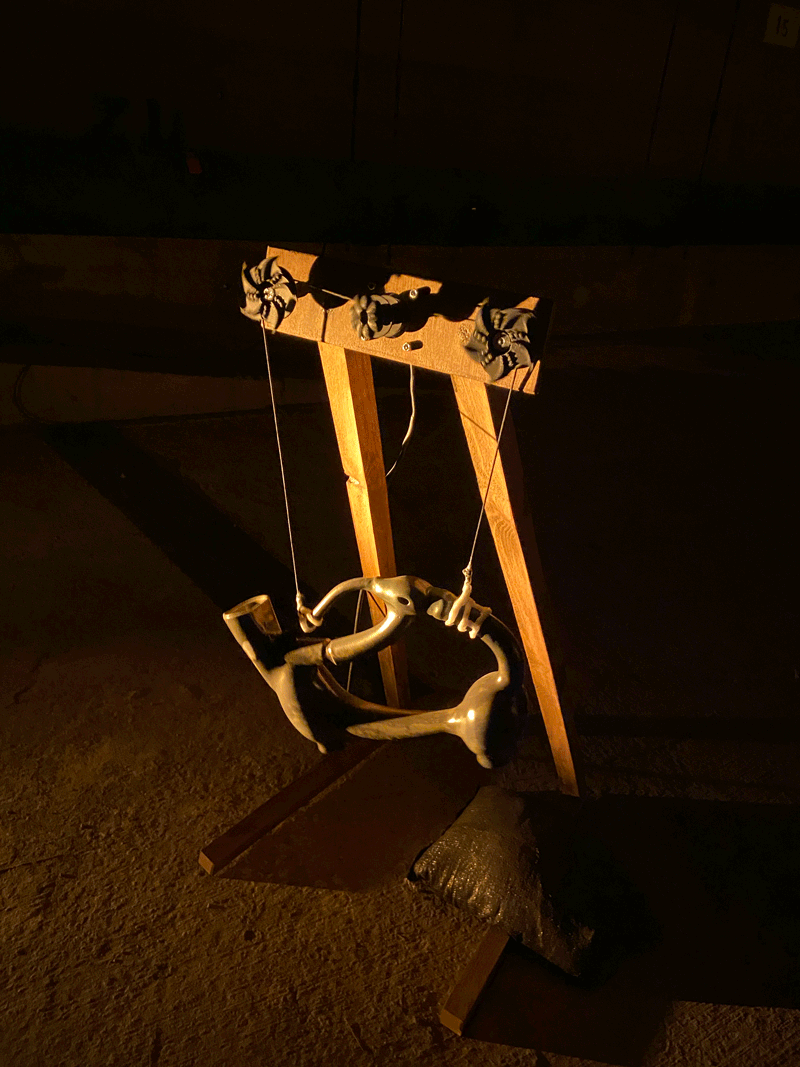
I’m preparing 12 questions to ask Pacheco, but I’m already suspecting that there is something in her work that those questions cannot fully grasp. Her work carries knowledge that is not solely gained through analysis and observation, but also through sensing, imagining, remembering and crafting. Many of her protagonists are nonhuman entities like wind, water or animals, and the practice of listening to, communicating with or simply respecting these entities has been very present in the culture Pacheco grew up in. Whereas in my childhood I had to enter a car to see nature instead of agriculturally exploited ground, and in my encounters with German folk culture, nature was always something that had to be tamed, fattened or fertilized. I know how to ask questions about starting points, work processes, influences and future plans, but I’m not sure how to ask questions about spiritual entities or transgenerational storytelling.
VP For the room in the middle, I have an anecdote. When I was doing my art memoir, the final written work in art school, I did a research trip to a subtropical region in the middle of Mexico. There is an indigenous group of people called Wixárika that have a really beautiful psychedelic approach. They are going on a pilgrimage to four different places in Mexico. One of these places is the Pacific Ocean. And there is a beautiful, huge rock in the sea. It’s all white because the birds have been doing poop since I don’t know how many years. And for them this rock has been the first object to get solidified when everything was liquid before life existed. So I went to see and try to catch some stories because I like storytelling. And a man started telling me stories about the delta that opens into this rock. He told me one story that is linked to sound hallucinations in nature. When he was a kid, he went fishing with his father in the Estero. This is a landscape full of mangroves and a lot of nature where the river becomes the sea. And it’s forbidden to fish there. But his father said, let’s go, because we can find nice fish there. And so they entered the Estero in his little boat, and they started hearing a crazy bass sound, like fffffuuuuu, a really shaking sound, a lot of different sounds going and coming from the direction of the river, like fffffuuu ffffffuuuu, quite crazy and scary. Like creatures, animals, voices. And so they had to return. I like that story a lot. For a long time, I liked the idea of having sonic hallucinations in nature. When you listen really carefully in a subtropical jungle with your eyes closed, you can get into a lot of mesmerizing or scary possibilities of sound. So that inspired me to work with sounds that evoke these soundscapes, but that can also give many other possibilities of images.
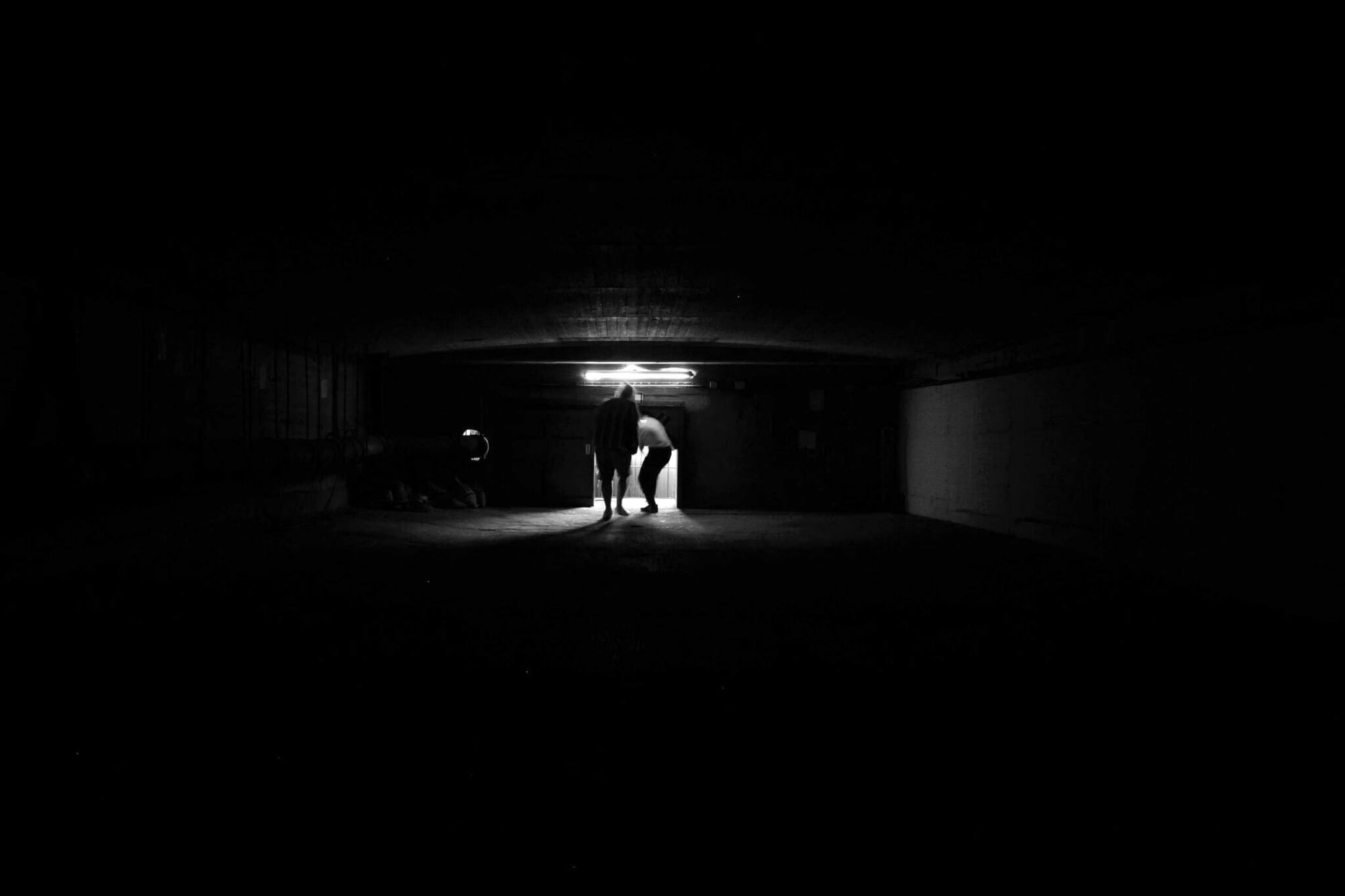
A few days pass until I can finally see OCCARESCENCIA fully installed. Volker Zander will be guiding me and eleven other visitors through the bridge. Before the tour, he tells us that when Pacheco came to the bridge for the first time, the space reminded her of a cave, and in caves some of our senses become sharpened, while others lose their reliability, making us see and hear things that might not even be there.
Zander also introduces the bridge etiquette to us. Yes, all of us enjoy documenting our lives with our phones, but would we be able to give pure listening and experiencing a chance?, he asks. The question won’t be discussed: Smartphones are not welcome on the way to the end of the bridge, on the way back we can take photos and videos if we need to. It’s a good rule, so nobody complains.
VH
When you create your sculptures, do you already have a specific sound in mind that you would like them to produce, or does the sound always come as a surprise?
VP It’s always a surprise, but I have some principles of acoustics. If I am doing a really tiny flute, it’s going to sound really high pitched. Or if I am doing a bigger one, it might sound more round. So I have those kinds of principles, but in the end you never know in ceramics. Each object will have a completely different tone personality. For the third room, I made 80 little bowls out of clay. They are super, super thin, almost no weight. They all follow the same principle: I had a plaster bowl, I took a little bit of clay, and so I just followed the shape of the bowl with my fingers. So all of them are made in the same way. And yesterday I was trying them with the microphone to see how the space resonates inside them. The difference in sounds is crazy. It was really just the sound of the space inside these little balls. There are micro variations of everything in ceramics. Temperature, thickness, or whatever, it’s going to change the acoustic. It’s exciting. With the vases, as they are hydraulic, I was imagining shapes where water can flow freely in sensual ways, because I had the impression that if I did square shapes, it would not be natural. I got inspired by organs like the stomach, the intestine, shapes for fluids to move inside of us. And I was imagining snakes. I do a lot of 3D for my work, and during that process of modeling it’s also just about trying out prototypes and seeing what works better than other things.
We walk up a few stairs and duck through an adventurous-looking opening that leads into the belly of the bridge. On the other side, we all encounter the cave-effect: our light-accustomed eyes only see darkness for the first seconds, so counting on them to guide us is not a recommendable strategy anymore. After a few seconds of clumsy tapping, I’m starting to trust my feet and sense of balance, slowly becoming ready to acknowledge the sound and the space. Two dimmed pink light spots in the distance entice us to take the softly ascending and descending path forward.
Moving through the bridge-sized composition feels like walking through a forest with thousand eyes where invisible birds and snakes notice the intruder long before he sees and hears them. When I finally arrive at some of the noises’ sources, it reminds me of when I once was alone at home, scared by strange loud unknown noises, just to find a tiny little mouse causing all the fuss: what I discover in the bridge is small creatures, busy like gear wheels, making a lot of noise while spinning, quaking and swaying. Pacheco and her assistant Élie Bolard built those little fragile instruments, 8 in total, all of them involving electronic, digital and manual crafts. This is why Pacheco’s exploration of folk culture is never an antimodern escape into a mystified idealized past. It is these most modern technological processes that make the instrument-creatures live in the present.
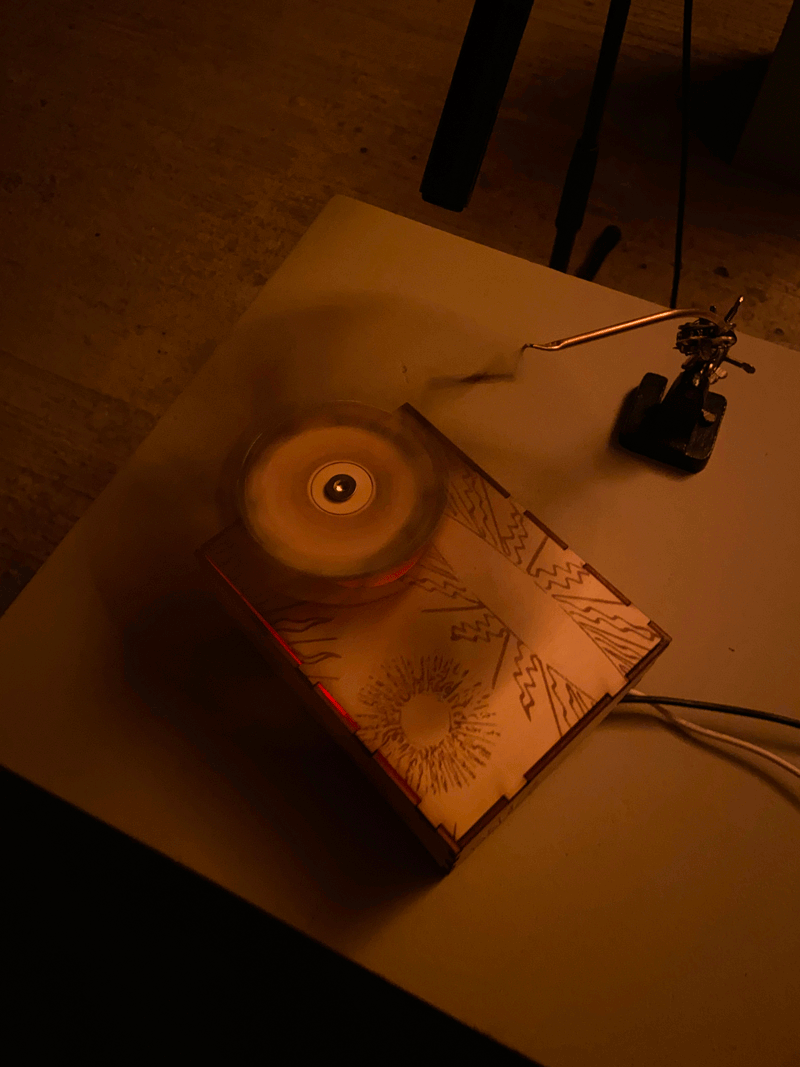
VH
Your work includes a lot of different skills: sculpting, 3D modeling, knowledge of sound and many more. Where did you learn those skills?
VP Little by little. The school I went to in France was a really nice school because they let you do whatever and they have all possible tools. I really lost fear of trying complicated things there. Like, okay, what is this, a microphone? Okay. Let’s try to understand more or less what it is. Can I use it? “Yes. You can have it for one week. Try it out.” So this kind of pedagogy helped a lot. Otherwise, where I come from, we are famous for having a lot of crafts. It’s something super linked to life in Oaxaca, where I come from. It’s really easy to be in contact with someone who does something really precisely. It can be clothes, traditional wool or weaving. So you go, you learn, you create a relationship with it. And the third thing I can say is: Internet (laughs). You can learn anything on YouTube. So I learned 3D on YouTube because I started using a program called Blender. It’s free and you can find everything on the internet. So I spent a lot of hours trying to do things and then I said, okay, now I know this and then you start mixing.
Each of the three bridge sections is inhabited by one species of sound makers that are put under dimmed light spots, pink and orange clearings in the dark: Conejo and Rama, the two hydraulic flutes, are calling each other from one corner to the other in the first room. In the second room, wooden turntables (a word that is already a reference to Pacheco’s work both with sound and clay), cheeky metal fingers and directional microphones are making the textures of five 3D-printed vases and wheels audible. And in the third room, a big family of very fragile brown half eggs are persevering on a round membrane that, at intervals, vibrates heavily, making the eggs that are filled with little beads shiver and shake. I could fill a whole article by describing the countless little details from laser engravings to fingerprints that make you want to look at each of the objects very closely – instead of attempting to keep up with the dimensions of the bridge, Pacheco makes us look out for the smallest things.
VH
Your work is all about nature, ancient cultures and communication between different forms of being. What is it like for you to live in a Western European city?
VP Oh my god. It’s something. It’s a kind of dual way of living because I feel alive and inspired in nature. I admire my friends that are in Oaxaca and that have a clearer contact with what I am talking about all the time, you know? I have two friends in Mexico, neighbors of mine. One is a ceramist and the other is an artist. We are from the same town, from the periphery of the city. We live near los cerros, little mountains and natural reserves. I see them living their lives, and it’s true that I’m jealous. But I’m postponing it a little bit. For me it’s interesting to have the interaction of the city, of the humans. I have my closest friends in Brussels. I think I’m not ready either. I want to come back to Mexico, it’s beautiful. But it also has a lot of ugly things. I appreciate the freedom I have here as a woman. Freedom in the sense of moving. Moving in the dark, you know, like being free… Mexico sometimes is a little bit dangerous for a woman. Next week I will be alone in Guadalajara and I’m already picturing myself not going out alone too late because I don’t feel safe. And that’s something that makes me say, okay, chill, you’re good here. You do your projects, you come back. So I think it’s the social approach, the cultural thing that makes me wait here a little bit. I’m still picturing myself living my second adult life in Mexico, because in the end, that’s what I want. That’s where I come from. For the moment, I’m doing my things here, because nobody will ask me to do an installation inside a huge bridge in Mexico. To be honest, when I go there, it’s sometimes hard to work because you just enjoy. It’s another way to approach culture. It’s more about living, living the tradition, living the food, living the way of being… It’s different and I don’t have the same work opportunities there.
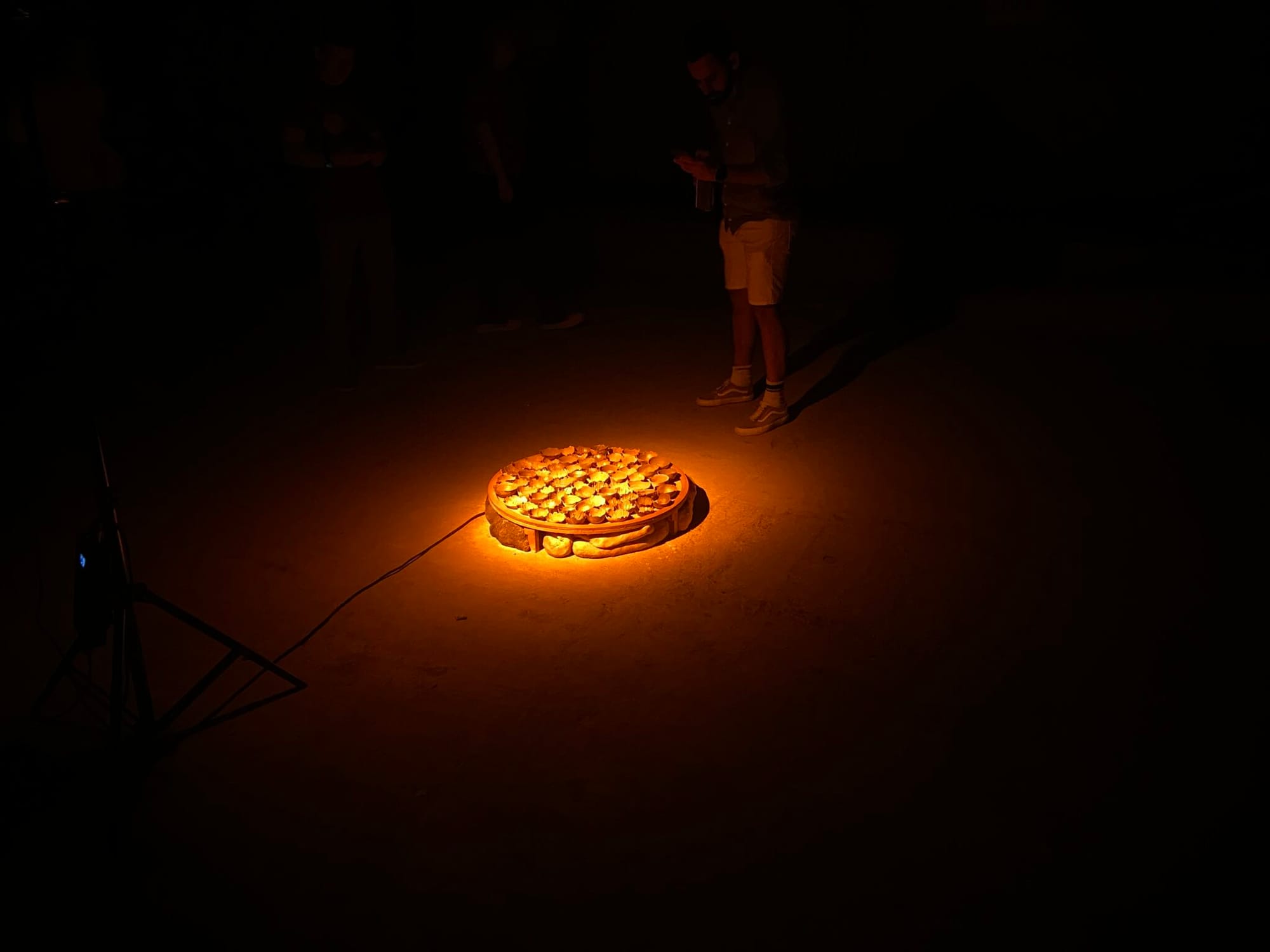
The soundscape of the little instrument-machines is supplemented by an open pre-recorded sound composition that leaves enough space for the local noises of the site: the vibrating deep base of the tram riding over the bridge, or the clackclack of cars driving over the bridge’s tiles.
But it’s not only the instruments and the prerecorded soundscape that make the composition. The walking visitor and the bridge itself become the mixers of the piece. The three parts of the bridge are separated by thick concrete walls with one door size passage each. These walls do a good job at distinguishing the three sound pieces, so by walking, the visitor can level the different components of the composition.
While in the sound composition, many layers of the sounds only slowly reveal as the ear becomes wider and time passes, the installation of the astonishing instrument-creatures is rather static. It’s impossible to miss the brightly lit clearings in the bridge’s centers and the walking path is obvious. I would have liked to search and discover in the dark a bit more.
VH
You said your parents were very supportive in your choice to become an artist. Were they ever worried about how you make your living?
VP No, they are really cool. I’m really lucky. They have a restaurant. I literally grew up there. And this restaurant is a beautiful, beautiful place. It’s my house at the same time. It exists already for 34 years, it’s like an institution. A really nice place for tasting traditional Mexican food. My mom, I consider her an artist, and she considers herself that way, too. They elevate the work they do into this amazing labor to feed people. And since I have memory, they’ve always been super admiring of the artists that come to the restaurant. They’ve always been like, ohhh, el maestro! I think they always thought of artists as people that know things that others don’t know. I think that this way of thinking allowed me to study art. They never, never, asked, what are you gonna live off? Never. They were more into, how are you going to do this? Where do you want to go? When I applied for the National art school for the first time, I got refused. I was crying in the taxi, and my mom said, don’t worry, I will support you! Why don’t you stay in the city, also to try out what it is like to live in the city? This was a super beautiful present from my mom. They never were scared. It’s also a link to Oaxaca. Oaxaca is really into el artista. They admire a lot what an artist can do for the community. I’m really lucky, because I heard the opposite story many times, and I feel sad because I don’t think it’s a good way to kill dreams like that.
VH
Can you make a living from arts, or do you have a side job?
VP Now I can. But I started with working in a sandwich place, then with that money I bought my tower computer. With my tower computer I started learning 3D. And with 3D I started working for other people. I did a lot of artwork and music videos for electronic music. And then little by little with the same techniques I started doing my own things. Then recently I started doing music for performances. I love to do music for theater or for dance. It’s nice to see your music in others‘ bodies and others’ ideas.
VH
What does your workplace look like?
VP That’s an amazing question because I don’t have one. I’ve been a nomad for 3 or 4 years with my work. That’s also why I want to stop moving all the time. I live in Brussels, so I have my sound studio in my apartment. For me it’s the most essential thing to have a studio where I can do music and sound. Otherwise, I don’t have an atelier. I move a lot from residency to residency, project to project, and I want to change that. But that’s where the question you asked me before about where I want to live comes in. Where should I put my studio? Should I make this thing bigger? Am I a plastician, am I a performer?
It’s another evening of a warm, sunny August day, and the bustling Altstadt that welcomes us back in front of the Deutzer Brücke knows nothing about the forest above the Rhine. And again, the light must be different for Vica Pacheco, since it’s ten in the morning where she is at that moment. Once again, she is back in Mexico, preparing her first show with a gallery. She is a bit nervous of this new context that comes along with new conventions of presenting, interacting and selling, she admits.
VH
When you’re moving so much, what do you do so you don’t get lost? Is there something that you carry with you, like a portable home?
VP I have a few objects. I always have a little chicken with me. My boyfriend gave it to me. And on this trip I brought a little frog. It’s a little percussion toy. I like to travel with little toys. And I like the idea that your home is where your heart is. So I try to enjoy being with the people. That is super beautiful and I try to keep contact with them afterwards. And I try to have my routine to feel at home, like my yoga in the morning, trying to eat my eggs in the morning because it’s important. Sleep… you know, these kinds of things. But at the moment it gets tiring. This year has been a challenge also. I miss my friends in Brussels a lot. I miss my plants, my apartment. So I’m trying to find out how to deal with that. I never imagined that my work would make me move so much. So you try to adapt, and you realize, okay, this summer I will not go to festivals with my friends, I have to work and just go get it. I try to not think about it too much and just enjoy it while I am in the moment. And I try to enjoy food. That’s my little péché that I really like to eat good because I grew up in a restaurant, so I try to allow myself to try the local specialities and find a nice place to eat good.
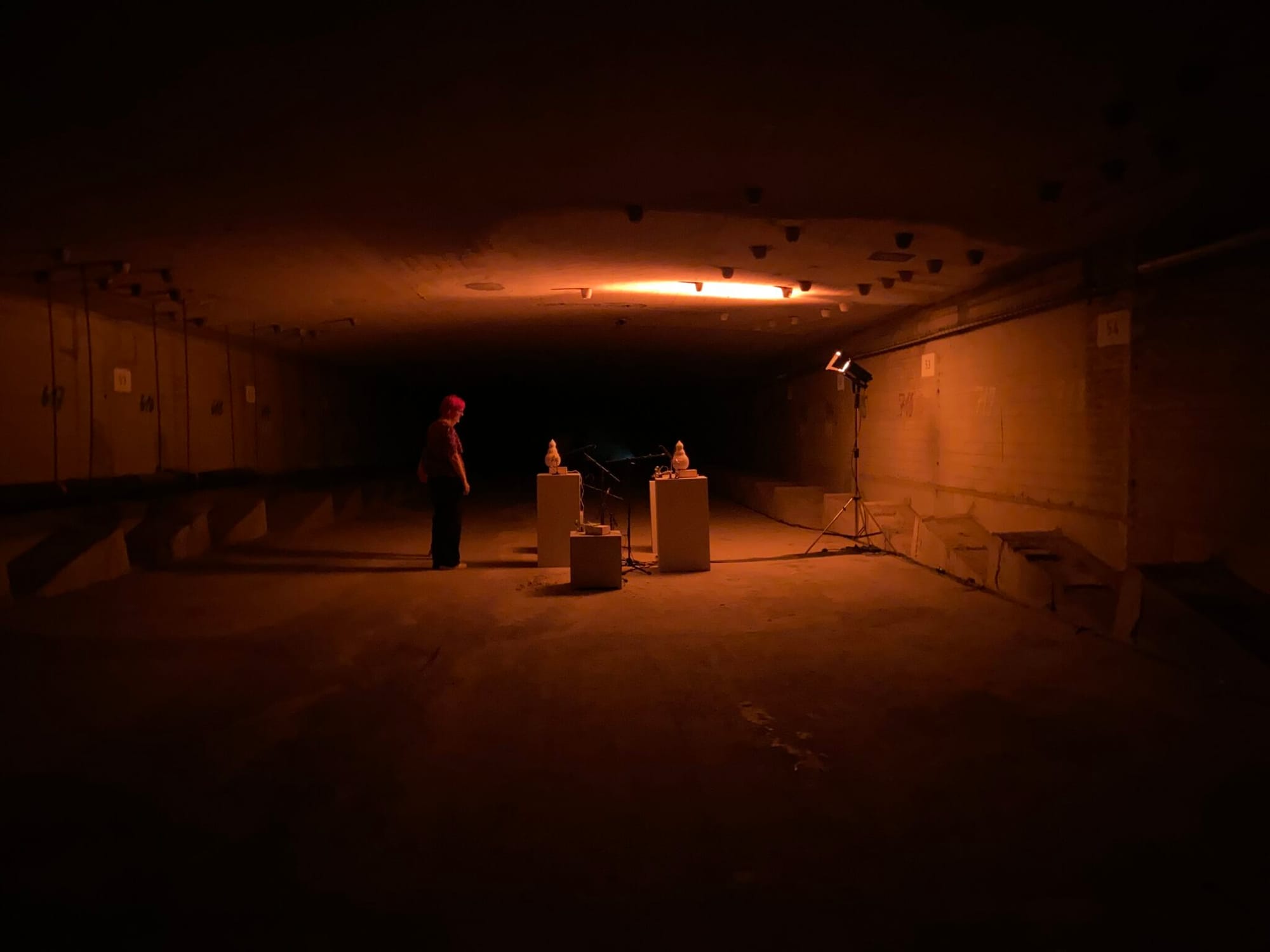
VH
Is there anything else you would like to try out or explore in the future?
VP I accidentally built a tambour, a percussion instrument while doing my piece with the little bowls. And I thought maybe one day I can also do percussion. So I’m into making instruments. And since one year I’ve been working on a project with flutes that work with steam. I want to do this with my mom because it’s about cooking and music and the way we relate to each other through many materialities. And to be honest, I want to do one, maybe two albums. I’m super like, that’s my project!
VH
You’ve already done one, right?
VP Yes, but it’s already been a while. So now I have this idea. It’s exciting.
Bonus material:
Listen to Vica tell how she received a Sheng from the best Sheng player of Hong Kong and made a friendship with a beautiful bird.
* Schälsick: an expression in the local dialect for the right side of the Rhein river, meaning “wrong side”. This expression comes from pre-steamboat times, when horses were pulling ships over the rhine. When they moved up the river, they got blinded by the sunlight reflecting on the water. The horses got eyepatches and were thankful to be able to continue the work, but sad not to see the other half of Köln anymore, so they only spoke of that side as Schälsick / wrong side.
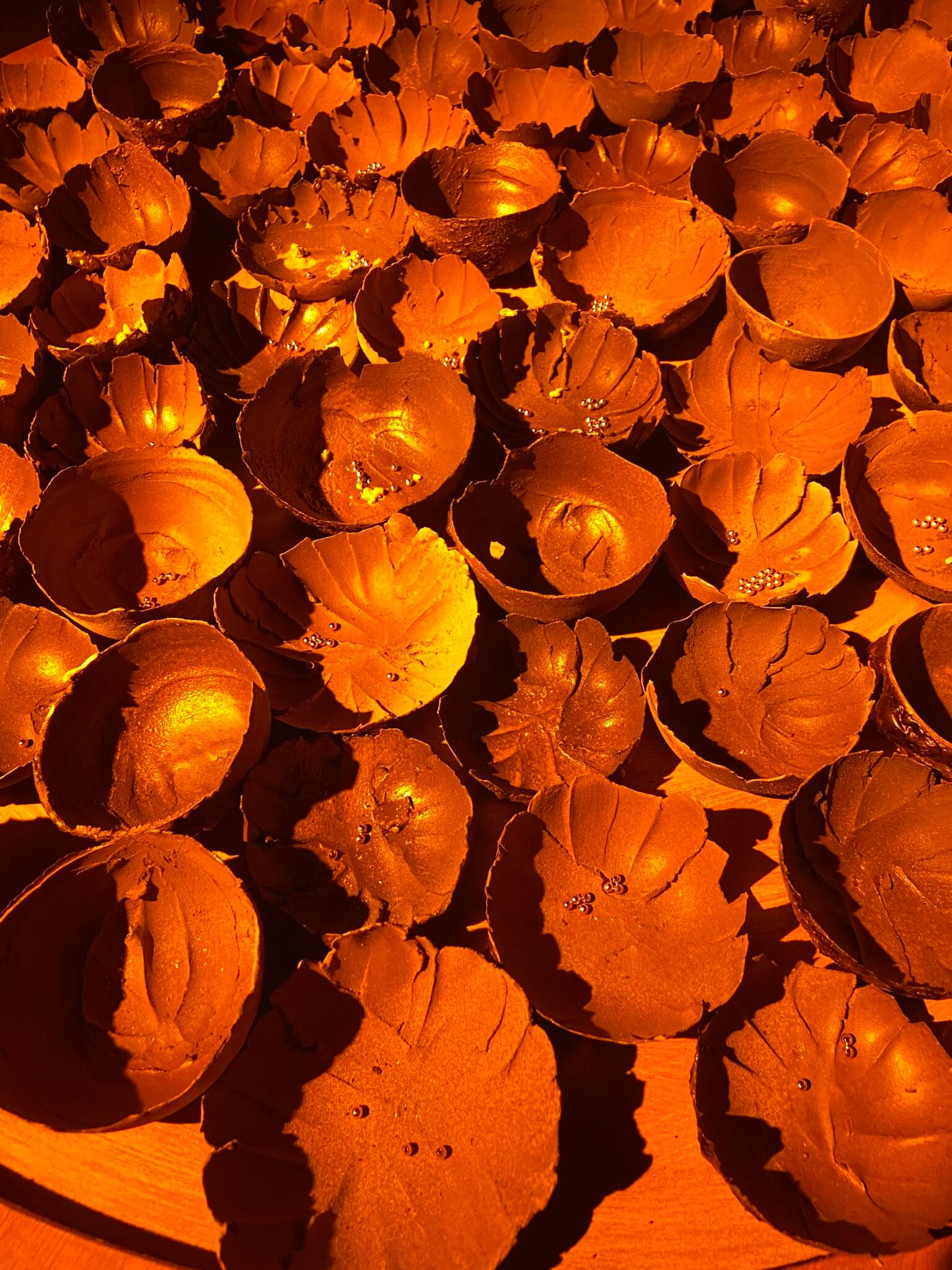
This article is brought to you by Noies Musik as part of the EM GUIDE project – an initiative dedicated to empowering independent music magazines and strengthen the underground music scene in Europe. Read more about the project at emgui.de.
Funded by the European Union. Views and opinions expressed are, however, those of the author(s) only and do not necessarily reflect those of the European Union (EU) or the European Education and Culture Executive Agency (EACEA). Neither the EU nor EACEA can be held responsible for them.
